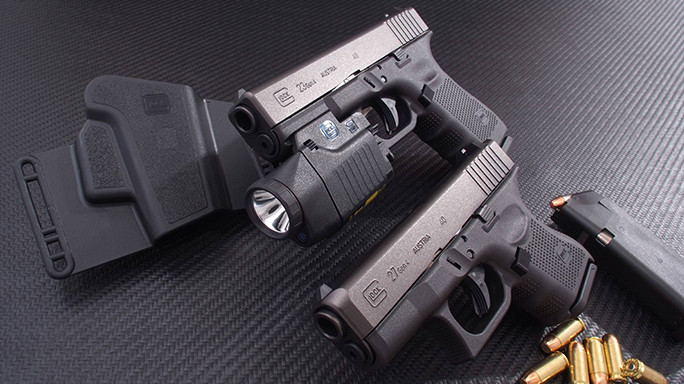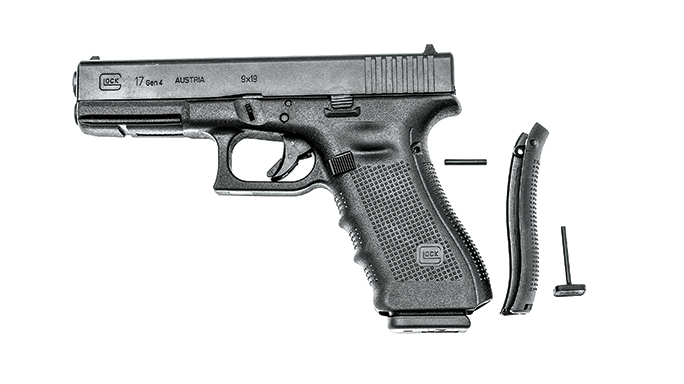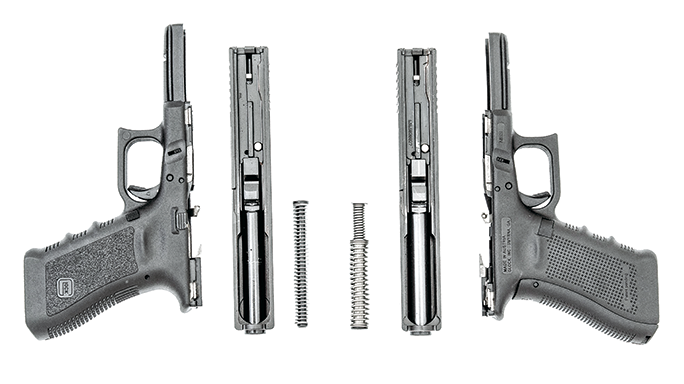The GLOCK design has been evolving since 1982, and numerous changes in external and internal features over the years have contributed to creating an impressive GLOCK lineage. At its core, a GLOCK is still the same gun introduced to the U.S. market 30 years ago, but the Gen4 design provides quicker handling, greater versatility and superior recoil management than its predecessors.
- RELATED STORY: 10 Drop-In Modifications To Consider For You Glock
The Gen4 embodies modifications developed for GLOCK pistols over more than a quarter century, plus features that GLOCK never previously offered. One of the most noteworthy developments prior to the Gen4’s introduction was the addition of a dust cover accessory rail in 1996. This was in step with the trend for military and law enforcement personnel to add tactical flashlights or lasers to their sidearms.
Another earlier innovation carried over into the Gen4 was an extractor with a raised flange that also functions as a loaded-chamber indicator by protruding slightly outward from the frame. This could be easily seen and, more importantly, felt under conditions that might demand immediate knowledge of the GLOCK’s condition in the dark.
Advertisement — Continue Reading Below
Get A Grip
The one hurdle that had not been addressed until the Gen4 was the gun’s original grip size. Initially intended as a military/law enforcement sidearm, the grip’s outer dimensions were eventually “averaged” for use by a broader range of shooters. In today’s military and law enforcement community, and certainly in the civilian marketplace, average is a much greater variable than it used to be. To make GLOCK’s guns adaptable to a greater variety of hand sizes, the technology that went into the Gen4 grip design literally rewrote the book on interchangeable backstraps.
The Gen4 grip does not use interchangeable panel inserts to increase the size of the palm swell, as is the general practice. Instead, Gen4 technology uses a full-length backstrap panel that transforms the entire grip contour. On Gen4 models, the standard grip size is actually slightly smaller than all previous models, thus becoming the new “average.” The backstrap can be completely covered over by two alternate-sized panels—medium and large—that attach at the base of the grip frame and lock into position, with a cross pin passing through the top of the backstrap insert and frame.
Advertisement — Continue Reading Below
The key feature of this design is that it not only changes overall grip size to accommodate different hand sizes, but also the distance to the trigger, a crucial factor in grip contour and how it relates to individual users. Changing panels moves the first joint of the trigger finger farther away from the GLOCK’s SAFE ACTION trigger to achieve the ideal distance for an individual’s hand size and finger length.
The Gen4 package of enhancements also addresses another long-standing issue with lightweight, polymer-framed handguns chambered for large calibers: harsh recoil. Gen4 models use a new dual recoil spring and guide rod assembly with the primary recoil spring fitting over the guide rod (as before), only it is a heavier, more tightly wound spring, as opposed to the flat spring used previously. This assembly is then shrouded by an alloy case, around which is wound an even larger secondary recoil spring. This design significantly reduces felt recoil to minimize shooter fatigue and decrease muzzle rise. Finally, it also makes it easier to get back on target for follow-up shots.
Real-World Solutions
Advertisement — Continue Reading Below
The GLOCK Gen4 lineup offers easy handling, light felt recoil and the most adaptive grip system available. This doesn’t happen overnight, and GLOCK has never made changes for the sake of change, but rather to improve the performance of its guns and meet the needs of consumers, whether military, law enforcement or civilian.
For the Gen4 line, GLOCK began making improvements to its original design back in 1991 with a new integrated recoil spring assembly and an improved magazine design. Grip designs also changed over the years with checkering added to the frontstrap and serrations to the backstrap.
In the late 1990s, finger grooves were added to the frontstrap for an improved grip, and to meet the needs of both right- and left-handed shooters, thumb rests were added to both sides of the frame and the magazine catch was made reversible.
Advertisement — Continue Reading Below
- RELATED STORY: First Look: Glock’s New MOS Configuration G17, G19
The Gen4’s arrival in 2010 marked the latest evolution of a truly original design that continues to expand in terms of calibers and frame sizes. Today, GLOCKs are some of the most popular carry guns for civilian use, and GLOCKs are in use among 65 percent of U.S. law enforcement entities. That’s a true testament to what effective technology can accomplish.
For more information, please visit US.Glock.com.
This article was published in the GLOCK AUTOPISTOLS 2016 magazine. To see the rest of the issue, please visit Personaldefenseworld.com/publications/glock-autopistols/glock-autopistols-2016.
Advertisement — Continue Reading Below

























